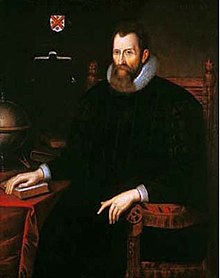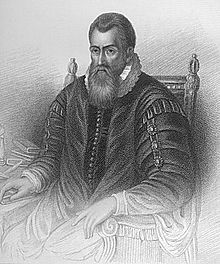John Napier
John Napier (also Latinized Neper ), Laird of Merchiston (* 1550 in Merchiston Castle near Edinburgh ; † April 4, 1617 ibid) was a Scottish mathematician , naturalist and theologian .
biography
Napier was the eldest son of the Scottish Baron Archibald von Merchiston and received his education first at the University of St Andrews . Afterwards he probably traveled to Europe and acquired knowledge in mathematics and literature. In 1572 he received many of his father's lands. After studying theology, he also worked as a Protestant pastor. In religiously divided Scotland, he repeatedly attacked the Catholic Church and saw the Pope as an antichrist.
Napier and the Swiss Jost Bürgi developed the logarithm at about the same time, but independently of one another, as a calculation tool (1614, 1620) that was in use for centuries. In contrast to Bürgi's logarithms, which were hardly taken into account, Napier's invention was eagerly studied by scholars and, above all, rapidly developed by Henry Briggs (1556–1630).
Napier pursued the goal of being able to perform spherical trigonometric calculations purely logarithmically. For this purpose he developed important theorems of spherical trigonometry such as the half-angle theorem or Napier's analogies ( Logarithmorum canonis descriptio, 1620, pp. 47, 56). Napier's rules named after him are a concise summary of arithmetic formulas already known at the time for the right-angled spherical triangle , for which Napier gave an elegant proof ( Logarithmorum canonis descriptio, 1620, p. 56).
The Napier computing sticks had a significant impact on the development of computing machines . They made it possible for Wilhelm Schickard to build the first mechanical calculating machine.
In his honor, the auxiliary unit of measurement (pseudo- measure ) for damping electrical and acoustic vibrations was named Neper , but recently it has been increasingly replaced by the bel or decibel . In addition, the nit , a dimensionless unit of data volume that is no longer in use , was named after Napier .
One of the Edinburgh-based universities bears his name in his honor, Edinburgh Napier University . The university has several campuses all over the city . The Merchiston Campus, the university's oldest campus , grew up around Merchiston Castle , the birthplace and death place of John Napier.
The moon crater Neper is named after him. The same applies to Napier Island in Antarctica.
Fonts
- Mirifici logarithmorum canonis descriptio ejusque usus in utraque trigonometria etc. Edinburgh 1614.
- Logarithmorum canonis descriptio; Tabula canonis logarithmorum; Mirifici logarithmorum canonis constructio. Bartholome'e Vincent, Lyon 1620.
- Rabdologiae seu numerationis per virgulas libri duo. Edinburgh 1617 (German adaptation by D. Bayr and Franz Kessler: Artificial arithmetic rods for advantageous and easy variation , Strasbourg 1618, digitized version ).
- A Plaine Discovery of the Whole Revelation of St. John. Edinburgh 1593.
literature
- Margaret E. Baron: Napier, John . In: Charles Coulston Gillispie (Ed.): Dictionary of Scientific Biography . tape 9 : AT Macrobius - KF Naumann . Charles Scribner's Sons, New York 1974, p. 609-613 .
- Anton von Braunmühl : History of Trigonometry, Volume 2. Leipzig 1903.
- U. Dietrich, K. Girstmair: John Napier's trigonometry - a look back. Math. Semesterber. 56 (2009), pp. 215-232.
- Lynne Gladstone-Millar: John Napier. Logarithm John . National Museums of Scotland Publications, Edinburgh 2003, ISBN 1-901663-70-1 (biography).
- Julian Havil : John Napier: Life, Logarithms, and Legacy. Princeton University Press, 2014.
- C. Knott (Ed.): Napier Tercentenary Volume. Longman, 1915.
- Mark Napier: Memoirs of John Napier. London / Edinburgh 1834.
- David Buchan: An account of the life, writings, and inventions of John Napier, of Merchiston. Perth 1787.
Web links
- Literature by and about John Napier in the catalog of the German National Library
- John J. O'Connor, Edmund F. Robertson : John Napier. In: MacTutor History of Mathematics archive .
- Spektrum .de: John Napier (1550–1617) October 1, 2010
- Denis Roegel: Napier's ideal construction of the logarithms , 2010
Individual evidence
- ↑ Life data according to Margaret Baron: Napier, John , in Dictionary of Scientific Biography, from 1972.
- ↑ Eckart Roloff : Divine flashes of inspiration. Pastors and priests as inventors and discoverers. 2nd Edition. Weinheim 2012, ISBN 978-3-527-32864-2 ; therein the chapter John Napier (1550–1617): It works without multiplication tables - just multiply with bars, pp. 146–148.
- ↑ A. v. Braunmühl: history of trigonometry . tape 2 . Leipzig 1903, p. 4, 10 .
- ^ Napier's analogies, Mathworld
- ↑ U. Dietrich, K. Girstmair: John Napier's Trigonometry - a look back . In: Math. Semesterber. tape 56 , 2009, p. 215-232 .
| personal data | |
|---|---|
| SURNAME | Napier, John |
| ALTERNATIVE NAMES | Neper (Latin) |
| BRIEF DESCRIPTION | Scottish mathematician |
| DATE OF BIRTH | 1550 |
| PLACE OF BIRTH | Merchiston Castle near Edinburgh , Scotland |
| DATE OF DEATH | April 4, 1617 |
| Place of death | Merchiston Castle near Edinburgh , Scotland |

